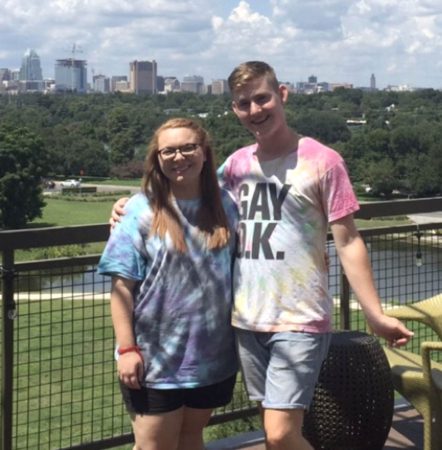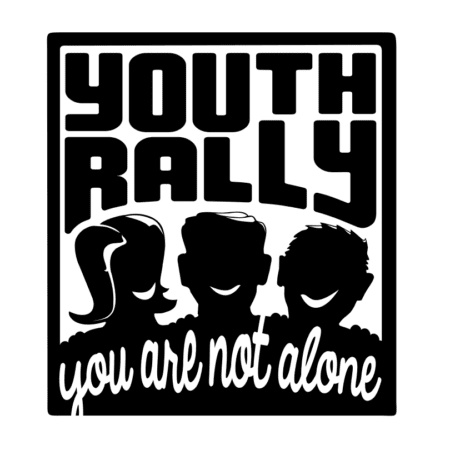For as long as I can remember, I have found myself fitting in amongst groups of people who don’t stereotypically “fit in.” I recognized early on that because I had an absent lifestyle, consisting of traveling hours away to cities with hospitals and specialists unavailable to me in western Kentucky, it gave me the freedom to be invisible.
I was born on a crisp, autumn Friday in September 1991. My mom’s earliest indication something wasn’t right was a large bruise that developed on my lower back, days after I was born. However, her concern was met instead with my pediatrician looking into her eyes and saying, “Some babies are just born special!” Special comes in many forms. For me, that included a mature, type 4 Sacrococcyxgeal Teratoma. This just means I had a slow-growing tumor that wreaked havoc on the organs surrounding the sacrum and coccyx and went undiagnosed because no one could see it.
In a world where it is easy to stay isolated and afraid of connection, I have found some of my closest companions were waiting for the same opportunity; hiding away behind their shields of invisibility.
A steady decline in my ability to hold my bowel and bladder, beginning well after potty training, was the next signal that I had something going on. However, it was not until I was seven when the tumor abscessed, that my childhood was shifted into a very real, life-long game of “Operation.” During my third Teratoma resection at the age of 14, my new colorectal surgeon advised that a temporary ileostomy would be needed to allow everything time to heal. Fortunately, the surgery was in May so I had the summer months to hide away as I wanted to.

JoAnna with her best friend Caleb whom she met at Youth Rally at is a natural companion whether attending a UOAA National Conference or a Pride Celebration.
I started my sophomore year of high school with the ileostomy, and having only had it two months at the time with little self-management, I resorted to staying home from school most days for the remaining two months until it was reversed. I found a bit more normalcy in my teen years, discovering friends with similar interests and personalities and things in their own lives making them special to distract from my ability to fade in and out of view.
A few years later, just before my 18th birthday, I left home to attend college in Tennessee. It was a new world and I could be anyone I choose. For the first time, I wanted to be fully present in every moment and not miss a thing. In reality, I spent what I remember feeling like almost all of my first semester of college writing papers while sitting on the toilet of a shared dorm suite. Through discussion with my surgeon and with the understanding that I didn’t want to hide away anymore, I decided it was time for a permanent colostomy in 2009. Not only did this decision provide the opportunity to be present and live life to the fullest but also allowed for new purpose and adventures, all on its own.
It was in 2011, attending my first year as a Counselor In Training at Youth Rally, which is THE camp for young people with bladder and bowel dysfunctions here in the US, that I was included with a group of counselors and campers affectionately labeled by the members as “The Island of Misfit Toys.” Truthfully, we were just the miscellaneous diagnoses group that didn’t have enough members separately to each have our own. The symbolism of being a misfit toy, that found belonging and purpose in a group of other misfits, has continued throughout almost every social group that I have been a part of.
The beauty of events like Youth Rally, as well as the UOAA Conference, is providing a safe place to build community without fear of judgment for identifying in a way that is taboo or sometimes uncomfortable to discuss. In a world where it is easy to stay isolated and afraid of connection, I have found some of my closest companions were waiting for the same opportunity; hiding away behind their shields of invisibility.
way that is taboo or sometimes uncomfortable to discuss. In a world where it is easy to stay isolated and afraid of connection, I have found some of my closest companions were waiting for the same opportunity; hiding away behind their shields of invisibility.
Not only had I grown into a person who wanted to be known and accepted, but more importantly, I wanted to be chosen and loved. I grew up as a girl in the Bible Belt, with the idea that someday I would find a man who would love me and my ostomy, and then everything else in the world would make sense. Intimacy was scarce, considering my body confidence issues, so I resolved to wait. I had faith that my person would come along and I would know when it was right. Just as I had spent other portions of life in the shadows, wishing and waiting for my moment to come, it would probably surprise no one that another place that I had stowed away was inside “the closet.”
Like my experience in the Ostomy community, identifying as a member of the LGBTQIA+ community has provided a safe place to be authentic and explore who I am and want to be as a person and partner. The intersection at which these identities meet has given opportunity to some of the most profound and pivotal moments in my life. It would then also not be surprising that I attended Pride celebrations before and after “coming out” with my best friend, Caleb, whom I met while we were both first-year Counselors in Training at Youth Rally. He is the same friend that I invited to join me at the UOAA Conference as it made its way to my current city, his hometown, this past year. In our truest fashion, I am happy to say we show up loud, proud, and ready to make our place in the world; no matter the occasion.

I work daily to overcome my old habits of hiding away, having to refocus to remember that the life that I have created was done only by my participating fully. On the difficult days when I have trouble seeing for myself, I am blessed with friends and a partner who assist with some needed perspective. I aspire to be the same for every person I meet.
So, in case you are new here; no matter how you identify…
Hi! I am JoAnna and I am glad you are here.


